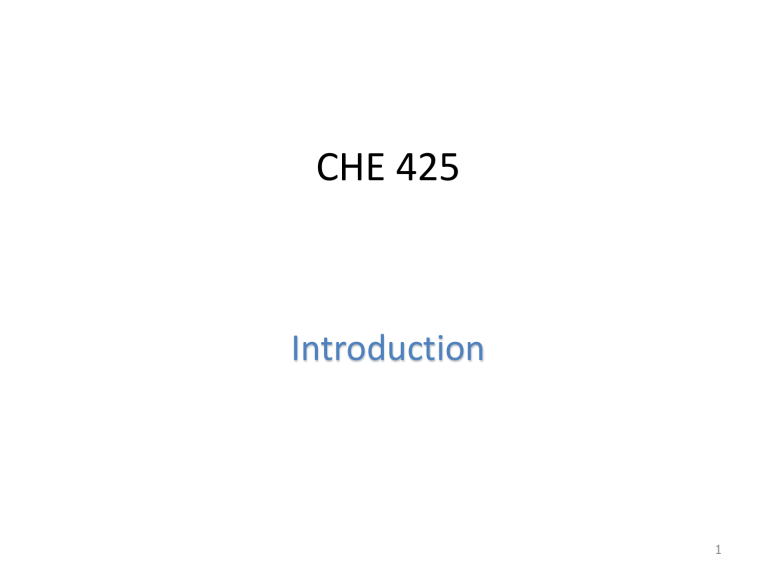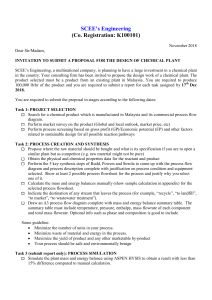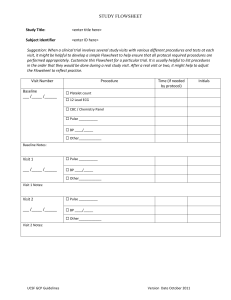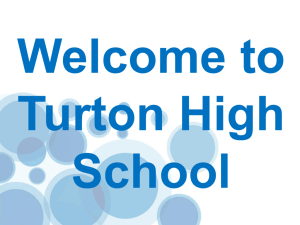
CHE 425 Introduction 1 MOTIVES FOR NEW PROJECT • PRIMERLY ECONOMICS (PROFIT MAXIMIZATION) • Other motives: – Strategic – Compliance 2 HOW CHEMICAL PROJECTS ARE INITIATED? • I spot a gap in the supply and demand of a product (or forecast a gap) • I have feedstock I want to monetize • I have an existing facility, but I want to maximize my value chain • I exploit a new technology 3 CHEMICAL PRODUCT TREE 4 PRODUCT CYCLES • Chemical engineers deal with products • Most products naturally have a life cycle 5 PRODUCT TYPES • Commodity/Bulk Chemicals • Fine Chemicals • Specialty/effect/functional chemicals 6 PRODUCT TYPES Copyright - R. Turton and J. Shaeiwitz, 2012 7 CHEMICAL PRODUCTS • Undifferentiated vs differentiated product Copyright - R. Turton and J. Shaeiwitz, 2012 8 IMPLICATION OF PRODUCT TYPE ON PROCESS DESIGN • In commodity chemical: – it is usually important to keep operating costs as low as possible. – Focus on process innovation – Dedicated equipment for specific process • In specialty chemicals: – Product innovation – Multipurpose equipment Copyright - R. Turton and J. Shaeiwitz, 2012 9 DESIGN PROBLEM FORMULATION • Usually ill-defined • Higher level examination • Don’t jump into design, it is costly Copyright - R. Turton and J. Shaeiwitz, 2012 10 SOME DEFINITIONS • • • • • Process Design Process Synthesis Process Analysis Process Simulation Process Flowsheet Copyright - R. Turton and J. Shaeiwitz, 2012 11 SOME DEFINITIONS Process Synthesis Process Analysis ? ? Copyright - R. Turton and J. Shaeiwitz, 2012 12 What is Process Synthesis? Process Inputs (Given) Process Structure & Parameters (Unknown) Process Outputs (Given) Process synthesis is concerned with the activities in which the various process elements are combined and the flowsheet of the system is generated so as to meet certain objectives. Hence, in process synthesis we know process inputs and outputs and are required to revise the structure and parameters of the flowsheet (for retrofitting design of an existing plant) or create a new flowsheet (for grass-root design of a new plant). 13 What is Process Analysis/Simulation Process Inputs (Given) Process Structure & Parameters (Given) Process Outputs (Unknown) Analysis is aimed at predicting how the synthesized process will perform. It involves the decomposition of the process into its constituent elements (e.g. units) for individual study of performance. Hence, once a process is synthesized, its detailed characteristics (e.g. flowrates, compositions, temperature, pressure, etc.) are predicted using analysis techniques. These techniques include mathematical models, empirical correlations and computer-aided process simulation tools (e.g. ASPEN Plus). In addition, process analysis may involve the use of experimental means to predict and validate performance. Therefore, in process simulation, we are given the process inputs and 14 flowsheet and are required to predict process outputs. Process Design = Process Synthesis + Process Analysis 15 SOME DEFINITIONS • Chemical Process – Unit operations – Unit conversions • Three Scales – Unit operations scale – Task scale – Phenomena scale Copyright - R. Turton and J. Shaeiwitz, 2012 16 SOME DEFINITIONS • Textbook: • “This crucial step in the design of the chemical plant involves all subareas of chemical engineering: reaction engineering, thermodynamics, process control, unit operations, transport phenomena, and material and energy balances” Copyright - R. Turton and J. Shaeiwitz, 2012 17 Homework • Homework #1: – Write a one-page essay on one chemical product of your choice, elaborating on the following: – Which category does the product belong to? – How the product exemplifies the features of its category? – Where does the product lie in the “chemical product tree”? – Line spacing: 1.5 – Font size: 11 Copyright - R. Turton and J. Shaeiwitz, 2012 18



